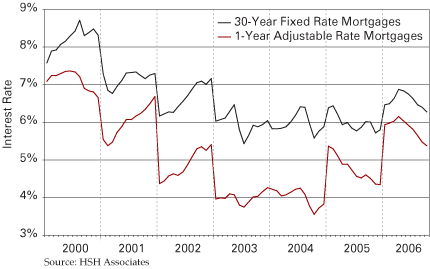Housing
Kelley School of Business, Indiana University, Bloomington
The big question as we approach the end of 2006 is whether the housing slump is over. Sales of new single-family homes rose 5.3 percent in September to a seasonally adjusted annual rate of 1.075 million units, according to figures released by the U.S. Commerce Department. The increase followed downward revisions to the sales rate for the previous three months, and the sales pace was down 14.2 percent from a year ago.
Total existing-home sales (including single-family, townhomes, condominiums, and co-ops) dipped 1.9 percent to a seasonally adjusted annual rate of 6.18 million units in September from a level of 6.30 million in August. This was 14.2 percent below the 7.20 million-unit pace in September 2005, which was the third strongest month on record.
The median price of new homes sold in September was $217,000, down almost 10 percent from a year earlier. This was the largest drop in thirty-five years and the median price for existing homes also fell.
For the third quarter as a whole, the Commerce Department reported that the median sales price was down by 1.7 percent on a year-over-year basis. There was a relatively rare year-over-year drop in median home prices with the September decline of 2.2 percent, the largest on record.
The supply of homes on the market is at its highest level in over thirteen years. The good news is that the number of homes on the market is starting to decline and home sales appear to be bottoming out with lower home prices. Recent declines in mortgage interest rates, reversing the trend of increasing rates, and a decline in energy prices have helped restore home buyer demand.
Existing-home sales are forecast to be fairly stable in the fourth quarter and sales for all of 2006 are expected to drop 8.9 percent to 6.45 million—still the third strongest year after consecutive records in 2004 and 2005. New-home sales are forecast to fall 17.3 percent this year to 1.06 million, the fourth highest year on record. Housing starts should be down 10.9 percent to 1.84 million in 2006.
With the recent correction in the market, the national median existing-home price is likely to rise 1.6 percent to $223,000 for all of 2006; it’s anticipated that prices will remain slightly below year-ago levels before gaining positive traction in the first quarter of 2007. The median new-home price is projected to decline 0.2 percent—largely the result of builder price cuts to move unsold inventory.
The thirty-year fixed rate is hovering around 6.3 percent and likely to stay at that level or slightly higher during 2007. Adjustable rate mortgages are in the 5.6 percent range for a one-year adjustable rate (see Figure 1).
Figure 1
Indiana’s Thirty-Year Fixed Rate Mortgages and One-Year Adjustable Rate Mortgages, 2000 to 2006

Existing home sales are likely to finish 2006 at around 6.4 million, down from slightly over 7 million during 2005. For 2007, sales are expected to be slightly under 6.4 million. New single-family unit sales are expected to be about 1.1 million for 2006, down from about 1.3 million in 2005 and are likely to be under a million in 2007. Housing starts should end up at around 1.8 million for 2006, down from slightly over 2 million in 2005 and are expected to drop to about 1.6 million in 2007.
Housing affordability has dropped steadily since peaking at 134 in 2004, which means that the median family has 34 percent more income than necessary to qualify for a mortgage on the median priced home. The affordability index dropped to 122 in 2005, is likely to end 2006 at around 106, and should remain at that level during 2007.
There are some risks to the economy if the housing market is not bottoming. Real estate downturns have a way of leading to recessions and stock market slumps. With home values falling, homeowners lose a source of spending money from refinancing, which has fueled consumer spending when home prices were rising. If cash-out refinancing (refi) by homeowners falls back to 2001 levels, it would drain $300 billion from the economy—which would have roughly the same impact as a $60 jump in the price of a barrel of oil. Cash-out refis were the only reason the economy weathered the gas-price hikes this year and last. The disappearance of cash-out refi money could dampen the economy.
Homebuilder stocks, including KB Home, DH Horton, and Lennar, have all traded at four or five times their earnings for the past twelve months—making homebuilding the cheapest sector in the S&P 500. But, of course, the question is what earnings will be over the next year.
In Indiana, the weakening of the housing market will continue, but to a lesser extent, according to Jerry Conover, director of the Indiana Business Research Center (see the Indiana outlook).
Also in this Issue…
- Outlook for 2007
- The International Economy
- The U.S. Economy
- Financial Forecast
- Housing
- Indiana Agriculture
- Indiana
- Anderson and Muncie
- Bloomington
- Columbus
- Evansville
- Fort Wayne
- Gary
- Indianapolis
- Kokomo
- New Albany
- Richmond
- South Bend and Elkhart-Goshen
- Terre Haute
- Indiana Metro Economies at a Glance
- Return to Table of Contents



